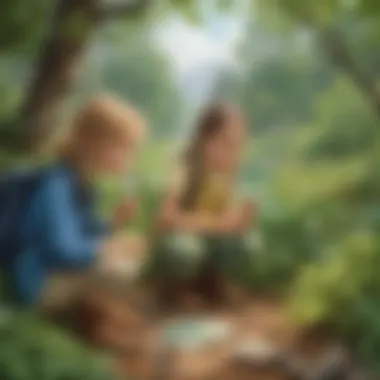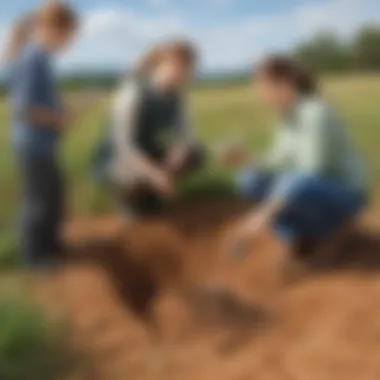Engaging Outdoor Science Activities for Kids


Intro
Engaging elementary students in outdoor science activities is a crucial avenue for fostering their curiosity and enhancing their understanding of scientific concepts. The natural environment provides limitless opportunities for exploration and learning. In this guide, we will delve into a variety of outdoor science activities that not only instruct but also stimulate a passion for science among young learners. Here, we blend hands-on experiences with scientific principles, creating practical knowledge while immersing students in their surroundings. This exploration emphasizes the significance of integrating outdoor activities into educational settings, ultimately benefiting both educators and caregivers.
Science Fun Facts
Understanding science can be greatly enriched by intriguing facts and stories that capture the imagination of young minds. Here are some points of interest that may pique the curiosity of children:
- Did you know that honey never spoils? Archaeologists have found pots of honey in ancient Egyptian tombs that are over 3000 years old and still perfectly edible.
- The heart of a shrimp is located in its head. This odd anatomical feature might fascinate students and lead them to dig deeper into marine biology.
- Bananas are berries, but strawberries are not! This twist on fruit classification can inspire discussions about plant biology.
- The largest recorded snowflake was 15 inches wide. This record encourages students to consider weather phenomena and the science of snow formation.
"Science is not only a disciple of reason but, also, one of romance and passion." – Stephen Hawking
By sharing such facts, educators can spark interest and encourage children to ask questions about the world around them.
Discover the Wonders of Science
Through outdoor exploration, students can discover various scientific concepts in real-life contexts. Engaging with the environment allows for a deeper understanding of physics, chemistry, biology, and earth science. Here are effective ways to facilitate this learning process:
Exploring Various Scientific Concepts
Activities such as nature walks or garden projects can introduce students to ecosystems, plant biology, and meteorological changes. This practical exposure to science creates memorable experiences.
Educational Videos and Animations
Supplement outdoor activities with educational videos that explain the science behind what students observe. Resources like Britannica provide reliable content that can be used to reinforce learning.
Interactive Learning Tools
Utilize tools like magnifying glasses or field guides to help students engage actively with their discoveries. These tools promote inquiry and deeper observation skills.
Real-Life Applications of Science
Discuss how various scientific principles play out in everyday life, such as how plants grow towards sunlight or how weather impacts animals. This relevance can be inspiring for young learners.
Science Experiment Showcase
Hands-on experiments are among the most exciting ways to engage students in science outdoors. Here are some enjoyable experiments:
Fun and Engaging Experiments
- Plant Growth Experiment: Students can grow plants in different environments to understand the importance of sunlight and water.
- Water Filtration Test: This experiment shows how natural processes can filter and clean water.
- Insect Observation: Students can observe insects in their natural habitat and record their findings.
Step-by-Step Instructions
For each experiment, provide clear instructions that outline the objectives, procedures, and observations needed. Ensure students know why they are doing each step to keep them engaged.
Materials List
A simple list of materials needed for each experiment should be provided. For example:
- Seeds
- Soil
- Water
- Recycled materials for filtration
Safety Tips and Precautions
Safety should always be a priority. Remind students to wear gloves where necessary and to wash hands after handling soil and plants.
The End
Integrating outdoor science activities in learning not only enhances scientific literacy but also cultivates an appreciation for nature. The activities presented in this article serve as a foundation for future exploration that can lead to a lifetime of curiosity and learning.


Foreword to Outdoor Science Activities
Outdoor science activities hold a significant role in shaping young minds. By engaging elementary students with the natural world, these experiences foster a sense of curiosity and critical thinking. Learning outside the classroom environment offers unique opportunities that traditional methods often fail to capture. Instead of confined spaces and static lessons, children can immerse themselves in the dynamic processes that science represents.
Importance of Outdoor Learning
Engaging in outdoor learning brings forth a range of educational advantages. Studies have shown that such experiences enhance cognitive skills and promote retention of information. When students engage in hands-on activities, they often develop a deeper understanding of scientific concepts. For instance, observing plants directly in their habitats offers insights into ecology that cannot be fully conveyed through textbooks.
Outdoor environments provide context to theoretical knowledge. When children see the butterfly's lifecycle in action or the weather effects on soil erosion, these real-life occurrences solidify their learning. Moreover, learning outdoors has the potential to stimulate interest in scientific pathways, paving the way for future exploration in various scientific disciplines.
Benefits of Engaging with Nature
Engagement with nature benefits students far beyond academic knowledge. Physical activity, for starters, is an inherent part of outdoor exploration. Running, climbing, or simply walking enhances not only physical health but also mental well-being. Studies indicate that spending time in green spaces can reduce anxiety and promote focus.
Furthermore, outdoor activities nurture social skills. Collaborative tasks, such as group experiments, encourage teamwork and communication. Children learn to express ideas, negotiate roles, and resolve conflicts, creating a sense of community among peers. Here are some key advantages of engaging with nature:
- Enhanced Creativity: Nature stimulates imaginative thinking and creativity.
- Increased Focus: Natural environments have been shown to improve concentration levels in children.
- Stronger Emotional Connection: Regular interaction with nature fosters emotional bonds, leading to respect and care for the environment.
Incorporating outdoor science activities into the educational framework is crucial. It is about creating lasting memories and instilling a sense of wonder. By doing so, we prepare our future generations not only as learners but also as responsible stewards of our planet.
Types of Outdoor Science Activities
Outdoor science activities are vital in enhancing the learning experience for elementary students. By conducting these activities, children are not merely passive recipients of knowledge but are actively involved in their learning process. These activities promote curiosity, critical thinking, and engagement with the environment, making science relatable and enjoyable.
Through hands-on experiences, students can directly observe scientific concepts in action. They learn to ask questions, formulate hypotheses, and conduct experiments, which encourages a deeper understanding of various scientific principles. Selecting a mixture of activities ensures that all students find something that resonates with their interests, whether they are inclined towards biology, earth sciences, or physical science.
Biological Studies
Biological studies focus on living organisms and ecosystems. This allows students to explore biodiversity, life cycles, and relationships within nature. Activities such as observing plants, insects, and animal behavior can be very enriching. For instance, students can create a simple observation journal where they describe what they see during nature walks. By learning to identify local flora and fauna, they build an appreciation for biodiversity and the need for conservation.
Physical Science Experiments
Physical science revolves around understanding the properties and changes of matter, alongside the forces of nature. Simple experiments can easily be conducted outdoors. Students can explore concepts like gravity and friction through activities like rolling different objects down a hill and measuring their speed. They could also experiment with wind and motion by flying kites of various shapes. These experiments provide clear, visual representations of abstract concepts, making them easier to grasp.
Earth Science Exploration
Earth science activities allow students to understand their planet better. This can include studying soil composition, rock types, and weather patterns. For example, students can engage in hands-on soil testing by collecting samples from different areas and analyzing texture and composition. Such activities encourage students to appreciate the geological processes that shape the earth. Moreover, linking weather monitoring to seasons can enrich students' knowledge about atmospheric phenomena and predict changes in their environment.
Environmental Science Projects
Environmental science focuses on the interactions between people and the ecosystem. Activities such as creating a small garden or engaging in a clean-up drive illustrate human impact on the environment. Students learn about sustainability through projects that emphasize recycling and conservation. Gardening, for example, teaches them about the growth process while promoting responsibility and care for the environment. Through these projects, students understand their role in protecting nature and can become advocates for environmental stewardship.
By incorporating a variety of outdoor science activities, educators can create a rich tapestry of learning opportunities that foster a lifelong interest in science. Engaging students in this way is essential in cultivating their inquisitive spirit and expanding their scientific understanding.
Planning Outdoor Science Activities
Planning outdoor science activities is a critical phase that shapes the learning experience for elementary students. Thoughtful preparation can maximize the engagement of young learners and ensure they have enriching experiences outside the classroom. It involves several elements such as location selection, material gathering, and safety protocols. Each of these components plays a significant role in clarifying the objectives and aligning the activities with educational goals. With careful planning, educators and caregivers can foster curiosity in children and provide a meaningful context for scientific exploration.
Choosing a Suitable Location
Selecting an appropriate location for outdoor science activities is fundamental. The chosen site should offer diverse opportunities for exploration and learning. A nearby park, garden, or nature reserve can serve as an excellent backdrop for numerous activities. These locations should provide easy access, safety, and exposure to different natural elements. It is important to consider the age and capabilities of the students when choosing a site.
"The right location can transform a simple activity into a memorable educational experience."
Factors to consider when choosing a location include:
- Accessibility: Ensure the location is easily reachable for the children, considering walking distance and transportation needs.
- Safety: Evaluate the area for potential hazards like steep hills, water bodies, or harmful plants. Child safety must be a priority.
- Variety of Nature: A place with different plants, insects, or water sources promotes holistic learning about ecosystems and biodiversity.
- Space for Activities: Sufficient open space is necessary for various activities, from exploratory walks to scientific experiments.
Gathering Necessary Materials
Once the location is selected, gathering the right materials is the next step. The choice of materials influences the type of activities that can be conducted effectively. Planning ahead helps ensure that everything is ready for the day of the activity. Having the right tools enhances engagement and understanding.


Some materials to consider include:
- Field Guides: These can help students identify plants, animals, and insects they encounter. For instance, using a Peterson Field Guide can enhance the learning experience by fostering identification skills.
- Observation Tools: Binoculars for bird watching or magnifying glasses for looking at insects can be useful.
- Journals and Writing Tools: Allow students to document their observations and findings. This promotes reflection on their learning experience.
- Safety Gear: Depending on the activity, items like gloves, first-aid kits, or sun protection may be necessary.
Safety Considerations
Safety is a paramount concern in any outdoor science activity. This involves not just the physical environment but also the well-being of the students. Proper planning minimizes risks.
Important considerations include:
- Supervision: Ensure a sufficient adult-to-child ratio during the activities. Close supervision increases safety and engagement.
- Emergency Preparedness: Always have a first-aid kit available and be familiar with emergency protocols specific to the location. This includes the nearest medical facilities.
- Health Alerts: Be mindful of any allergies or health conditions among children, especially regarding substances in the environment like pollen or certain plants.
- Environmental Awareness: Teach students to respect nature. Inform them about not disturbing wildlife or damaging plants.
Examples of Outdoor Activities
Outdoor science activities play a vital role in developing scientific thinking among elementary students. Engaging students with hands-on experiences enhances their curiosity and pushes them to explore nature firsthand. By participating in these activities, children not only learn scientific principles but also gain an appreciation for the environment. The following sections outline specific outdoor activities that can be easily implemented in educational settings.
Nature Walks and Observations
Nature walks are fundamental in promoting observation skills. During these walks, students can observe different plants, animals, and weather conditions. Encourage them to take notes or sketch what they see. This activity helps them connect with their environment. They can ask questions like why certain plants grow in specific areas or how animals adapt to their surroundings. Each question can lead to deeper understanding of ecological relationships.
Weather Monitoring
Monitoring the weather involves recording daily changes. Students can learn to measure temperature, humidity, and wind speed using simple instruments like thermometers and anemometers. This activity encourages them to analyze patterns over time. They might notice trends in temperature related to seasons or the effect of weather changes on local flora and fauna. Collecting and interpreting weather data gives students a grounding in scientific method and enhances their analytical skills.
Plant Growth Experiments
Plant growth experiments provide insight into life cycles and ecological systems. Students can plant seeds in different conditions, such as varying soil types or sun exposure. Over weeks, they can observe growth changes and record their findings. This activity highlights the importance of nutrients and sunlight for plants. It also introduces concepts like photosynthesis and the role of plants in ecosystems, enriching their understanding systematically.
Soil Testing and Analysis
Testing soil can be an exciting way to delve into earth sciences. Students can collect soil samples from various locations and analyze their composition. They can test for pH levels or nutrient content using simple kits. This hands-on approach speaks volumes about the role soil plays in plant growth and the overall health of ecosystems. Engaging in this activity allows students to appreciate the complexity of soil as a living resource.
Insect Collection and Study
Collecting and studying insects opens a window into biodiversity. Students can use jars to catch insects, then observe their behaviors and characteristics under magnification. This exposure fosters a sense of wonder for the natural world and elevates their understanding of ecosystems. Additionally, they can research the role of insects as pollinators or decomposers. Emphasizing the importance of each species promotes environmental stewardship amongst young learners.
Engaging outdoor activities cultivate a sense of curiosity in students, making science an exciting exploration rather than a mere subject.
These outdoor science activities allow children to explore practically. They can witness scientific principles in action while cultivating a lifelong interest in nature and science.
Integrating Technology into Outdoor Activities
Incorporating technology into outdoor science activities can elevate the educational experience for elementary students. This blend of digital tools and nature not only makes learning more engaging but also caters to various learning preferences. By using technology effectively, educators and caregivers can enhance students' understanding of scientific concepts while instilling an appreciation for the natural world.
Integrating technology into outdoor activities provides opportunities for deeper learning and exploration.
Using Apps for Identification
Utilizing apps for identification during outdoor activities is a practical way to introduce students to the world around them. Applications such as iNaturalist or PlantSnap invite children to explore flora and fauna with confidence. These apps use image recognition technology, allowing students to take pictures of plants or animals and receive instant identification.
- Benefits of Using Identification Apps:
- Encourages curiosity by allowing students to discover and learn about diverse species.
- Offers immediate feedback and information, enhancing the learning experience.
- Connects students with a wider community of nature enthusiasts, fostering a sense of belonging.
In practice, students can spend time outdoors collecting samples or observing wildlife. Afterwards, they may use the app to identify what they collected. This fusion of technology and hands-on experience reinforces their learning and promotes active participation in field studies.
Digital Journaling
Digital journaling presents another innovative approach to enhance outdoor science activities. Using devices like tablets or smartphones, students can document their observations and reflections in real time. Apps such as Evernote or Google Keep allow young learners to write notes, add photos, and even record audio of their findings.
- Advantages of Digital Journaling:


- Facilitates organized and structured note-taking, essential for scientific exploration.
- Provides a platform for creativity, allowing students to express thoughts visually and textually.
- Creates an easily accessible history of their learning experiences, which can be revisited later.
In a natural setting, students engage in observations. They may note weather changes, detail the behaviors of insects, or sketch interesting plants. These activities encourage mindfulness and enhance critical thinking. After their outdoor excursions, reviewing these digital journals can serve as a valuable assessment tool for educators.
Measuring Success and Learning Outcomes
Measuring success and learning outcomes is vital for understanding the effectiveness of outdoor science activities. This section underscores how to evaluate if these engagements achieve their educational goals. It emphasizes the relevance of developing clear metrics and gathering feedback, which informs future activities. Establishing success criteria helps educators recognize what works and what may need adjustment to ensure meaningful learning experiences.
Setting Learning Objectives
Before any outdoor activity, it is important to set specific learning objectives. These objectives act as a roadmap, guiding both educators and students toward targeted outcomes.
- Clarity: Objectives should be clear and understandable, allowing students to know what they are expected to learn. For example, an objective could be, "Students will identify at least five local plants and describe their habitats."
- Relevance: Make sure the objectives align with broader curriculum goals. When objectives connect with larger concepts, students see the relevance of their outdoor experiences.
- Measurable Outcomes: Learning objectives should be measurable. This could mean students demonstrate knowledge through presentations, quizzes, or projects after the activity. Good examples include:
- Conducting soil pH tests and reporting results.
- Creating a digital journal to document observations and findings.
Having these structured objectives allows for a focused approach to learning, creating a path for students to follow while exploring complexities of nature.
Assessing Knowledge Retention
After outdoor activities, assessing knowledge retention is essential for evaluating how effectively the learning objectives were met. This process ensures that students not only learned during the activity but retained the information afterward.
- Quizzes and Reflection: Short quizzes or reflection exercises can measure what students remember. Asking students to write down three things they learned is a simple yet effective method.
- Projects: Assign projects that require students to apply what they learned in real-world contexts. For instance, students could create a presentation based on their findings during an insect study.
- Peer Discussion: Encouraging discussions in small groups allows students to articulate their understanding. This collaborative environment fosters deeper comprehension through teaching and sharing.
Regular assessments help in identifying gaps in understanding, giving educators insights on how to adapt future lessons.
Overall, focusing on measuring success and learning outcomes solidifies the educational value of outdoor science activities, ensuring they resonate deeply with students.
Challenges and Limitations
In exploring outdoor science activities for elementary students, it is necessary to acknowledge the challenges and limitations that can arise. Identifying them can lead to a more effective planning and execution of activities. Therefore, understanding these challenges helps educators and caregivers streamline their approaches.
Weather Constraints
Weather plays a pivotal role in outdoor activities. Elements like rain, extreme temperatures, or looming storms can disrupt plans. When conditions are not favorable, safety becomes a top priority. These unpredictable factors can affect not only the engagement level but also the success of the science activities.
Some key considerations include:
- Alternative Plans: Always have a backup plan ready. This can involve moving activities indoors or adapting them to suit the environment.
- Clothing Preparedness: Tailor activities to the weather. If it is cold or rainy, ensure students wear proper clothing. This promotes safety and comfort.
- Weather Monitoring: Use apps or websites to check forecasts. Planning can become more strategic when you know the probable conditions beforehand.
"Navigating through weather constraints is essential for the success of outdoor learning. Proper planning can minimize disruptions and enhance the learning experience."
Engaging Diverse Learning Styles
Another challenge is meeting the varied learning styles of students. Every child absorbs information differently. Some may thrive in a hands-on environment, while others prefer visual or auditory learning experiences. This diversity can create barriers to fully engaging every student during outdoor science activities.
To address these differences, consider the following strategies:
- Multi-Sensory Activities: Design activities that engage multiple senses. This could include conducting experiments that allow student to touch, see, and even hear different elements in nature.
- Group Dynamics: Encourage collaboration. Pair students with partners who have complementary strengths. Peer-learning can help bridge different learning styles.
- Adaptive Techniques: Be flexible and willing to adapt lessons on-the-go. If a particular method is not working, switching approaches can keep students engaged.
Closure and Future Directions
In concluding the exploration of outdoor science activities for elementary students, it is important to consider the lasting impact these experiences can have on young learners. Engaging with science in natural settings not only enhances knowledge but also cultivates a sense of curiosity and respect for the environment. As education continues to evolve, integrating outdoor learning into curricula remains essential. This engagement fosters critical thinking and problem-solving skills that are valuable in all areas of life.
Fostering a Lifelong Interest in Science
Creating a foundation for a lifelong interest in science starts with early engagement. Activities that allow students to explore, question, and discover help form a connection with the world around them. Through hands-on experiences, children often develop enthusiasm that carries into adulthood.
Here are some key elements to consider when fostering this interest:
- Encourage Exploration: Allow children the freedom to discover nature on their own terms. Unsupervised exploration can lead to unexpected questions and discoveries.
- Utilize Inquiry-Based Learning: Design activities that prompt students to ask questions. This approach encourages critical thinking and makes learning more meaningful.
- Promote Discussions: Facilitate conversations about their experiences during outdoor activities. Discussing findings helps solidify knowledge and encourages further inquiry.
"Learning is a journey, and the outdoors provides an endless classroom devoid of walls and constraints."
- Incorporate Technology Wisely: Using apps and digital tools while outdoors can enhance the learning experience. These tools can offer identification help or data collection options, bridging the gap between traditional science and modern technology.
Ultimately, the goal is to create an environment where science is viewed as an accessible and fascinating subject. The positive experiences children have with outdoor science can shape their outlook on science throughout their education and careers.







